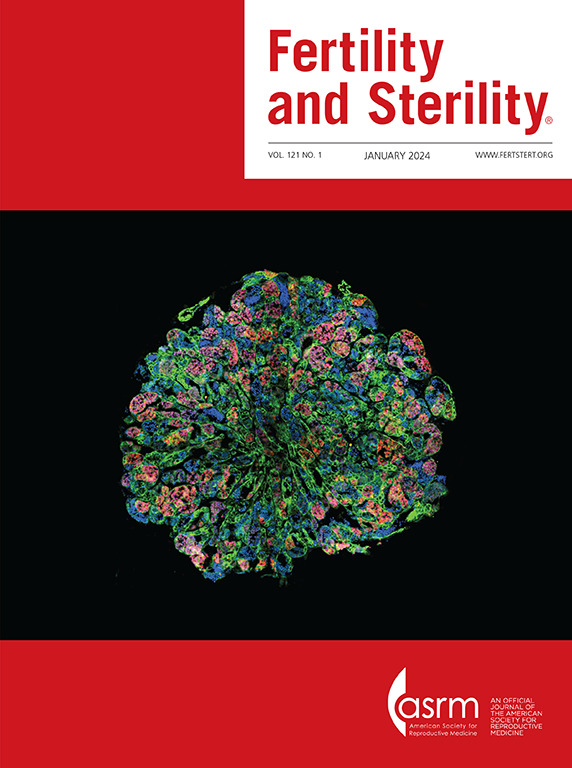甘油三酯-葡萄糖体重指数升高会增加体外受精和胚胎移植妇女流产的风险。
IF 7
1区 医学
Q1 OBSTETRICS & GYNECOLOGY
引用次数: 0
摘要
目的探讨甘油三酯-葡萄糖体重指数(TyG-BMI)对体外受精和胚胎移植(IVF-ET)妊娠结局的影响。设计回顾性队列研究。本研究纳入了来自中国三个生殖医学中心的17365例患者的临床数据,包括新鲜胚胎移植(ET)周期和随后的冻融胚胎移植(FET)周期。根据循环开始前测量的TyG-BMI四分位数将受试者分为四组:四分位数1 (Q1): < 166.9,四分位数2 (Q2): 166.9-188.8,四分位数3 (Q3): 188.8-218.8,四分位数4 (Q4):≥218.8。主要结局指标:累积活产率(CLBR)。第二项指标:生化妊娠率、临床妊娠率、流产率、活产率。结果较高的TyG-BMI与新鲜ET和FET周期流产率增加显著相关(新鲜ET周期:Q4 vs Q1: OR=1.41, 95%CI: 1.09-1.83, P=0.008; FET周期:Q2 vs Q1: OR=1.24, 95%CI: 1.06-1.45, P<0.001; Q3 vs Q1: OR=1.36, 95%CI: 1.17-1.60, P<0.001; Q4 vs Q1: OR=1.57, 95%CI: 1.34-1.84, P<0.001)。此外,在FET周期中,较高的TyG-BMI与较低的活产率相关(Q4 vs Q1: OR=0.88, 95%CI: 0.80-0.97, P=0.011)。在累积周期中,TyG-BMI较高的患者表现出明显较低的CLBR (Q2 vs Q1: OR=0.90, 95%CI: 0.82-0.99, P=0.025; Q3 vs Q1: OR=0.87, 95%CI: 0.79-0.95, P=0.003; Q4 vs Q1: OR=0.78, 95%CI: 0.71-0.85, P<0.001)。限制三次样条进一步证实了TyG-BMI与CLBR之间的线性负相关(p -非线性= 0.159,p总体< 0.001)。基于年龄和卵巢储备的亚组分析显示,高TyG-BMI对年轻女性(<35岁)、多囊卵巢综合征(PCOS)或卵巢储备正常的女性有更明显的不良影响。然而,在年龄较大(≥35岁)或卵巢储备功能减退(DOR)的患者中未观察到这种关联。结论随着TyG-BMI的升高,新鲜ET和FET周期流产率升高,FET周期活产率和累计活产率下降。这些发现表明,TyG-BMI可以作为一种实用的标记物,用于识别体外受精治疗前代谢风险增加的不良妊娠结局患者。本文章由计算机程序翻译,如有差异,请以英文原文为准。
Elevated triglyceride-glucose body mass index increases risk of miscarriage in women undergoing in vitro fertilization and embryo transfer.
OBJECTIVE
To explore the effects of triglyceride-glucose body mass index (TyG-BMI) on pregnancy outcome of in vitro fertilization and embryo transfer (IVF-ET).
DESIGN
Retrospective cohort study.
SUBJECTS
This study included clinical data from 17365 patients across three reproductive medicine centers in China, encompassing both fresh embryo transfer (ET) cycles and subsequent frozen-thaw embryo transfer (FET) cycles.
EXPOSURE
The subjects were categorized into four groups according to the TyG-BMI quartiles measured prior to cycle initiation: Quartile 1 (Q1): < 166.9, Quartile 2 (Q2): 166.9-188.8, Quartile 3 (Q3): 188.8-218.8, Quartile 4 (Q4): ≥ 218.8.
MAIN OUTCOME MEASURES
Primary outcome: cumulative live birth rate (CLBR). Second outcome: biochemical pregnancy rate, clinical pregnancy rate, miscarriage rate and live birth rate.
RESULTS
A higher TyG-BMI was significantly associated with increased miscarriage rates (fresh ET cycles: Q4 vs Q1: OR=1.41, 95%CI: 1.09-1.83, P=0.008; FET cycles: Q2 vs Q1: OR=1.24, 95%CI: 1.06-1.45, P<0.001; Q3 vs Q1: OR=1.36, 95%CI: 1.17-1.60, P<0.001; Q4 vs Q1: OR=1.57, 95%CI: 1.34-1.84, P<0.001) in both fresh ET and FET cycles. Additionally, a higher TyG-BMI was associated with lower live birth rate (Q4 vs Q1: OR=0.88, 95%CI: 0.80-0.97, P=0.011) in FET cycles. In cumulative cycles, patients with a higher TyG-BMI exhibited a significantly lower CLBR (Q2 vs Q1: OR=0.90, 95%CI: 0.82-0.99, P=0.025; Q3 vs Q1: OR=0.87, 95%CI: 0.79-0.95, P=0.003; Q4 vs Q1: OR=0.78, 95%CI: 0.71-0.85, P<0.001). The linear negative correlation between the TyG-BMI and CLBR was further confirmed by the restricted cubic splines (P-non-linear = 0.159, P-overall < 0.001). Subgroup analyses based on age and ovarian reserve revealed that a high TyG-BMI had a more pronounced adverse impact on younger women (<35y) and those with polycystic ovary syndrome (PCOS) or normal ovarian reserve. However, this association was not observed in older patients (≥35y) or those with diminished ovarian reserve (DOR).
CONCLUSIONS
As TyG-BMI increased, the miscarriage rates in fresh ET and FET cycles increased, while live birth rates in FET cycles and cumulative live birth rates declined. These findings suggest that TyG-BMI may serve as a practical marker for identifying patients at increased metabolic risk for adverse pregnancy outcomes prior to IVF treatment.
求助全文
通过发布文献求助,成功后即可免费获取论文全文。
去求助
来源期刊

Fertility and sterility
医学-妇产科学
CiteScore
11.30
自引率
6.00%
发文量
1446
审稿时长
31 days
期刊介绍:
Fertility and Sterility® is an international journal for obstetricians, gynecologists, reproductive endocrinologists, urologists, basic scientists and others who treat and investigate problems of infertility and human reproductive disorders. The journal publishes juried original scientific articles in clinical and laboratory research relevant to reproductive endocrinology, urology, andrology, physiology, immunology, genetics, contraception, and menopause. Fertility and Sterility® encourages and supports meaningful basic and clinical research, and facilitates and promotes excellence in professional education, in the field of reproductive medicine.
 求助内容:
求助内容: 应助结果提醒方式:
应助结果提醒方式:


